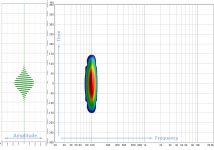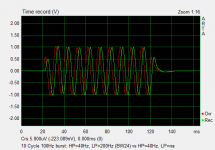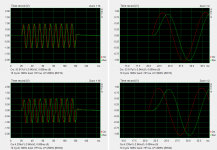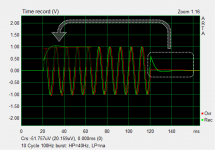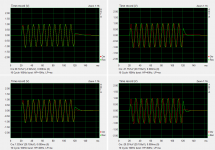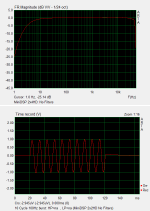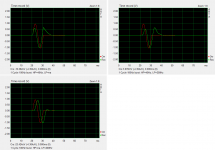Not quite sure what to make of that!
There is a reductio ad absurdum argument confirming that we have to disregard the fft performed over the time period which includes the time when there is zero output.
The attachment shows the fft of the same single cycle sinewave when it is in the middle of 20 seconds of no signal. The fundamental is showing at -60dB, whereas it should be at 0dB. It's clearly an absurd result.
The implication is that the screenshot in my post #56 and the first screenshot attached to post #58 are correct, and it follows (I think!) that there is no requirement for a system bandwidth beyond that of the sinewave frequency, regardless of whether there is one cycle or many.
Attachments
The naturally occurring "N" waveform of a thunderclap would have some similarity to a truncated sine wave like Mark posted.
Although I have heard the "crack" sound of randomly truncated sine waves many times when un-muting them through a good full range system, having been within 100 feet of a lightning strike two times in my life, have to say there is no sound system that has come very close to reproducing that sound.
And that's fine by me- but still wonder what the OP Wonderfulaudio application is...
Art
Hi Art, yeah...there's no sound like a close lightning strike...I've fortunately only had one within 100ft.
Blew a crater in the ground at a gutter downspout. That house had 13 lightning rods on it and wasn't all that big....guess I should have suspected something when I bought it. lol.
I've heard the rifle crack out of my PA too, ... always embarrasses.
Had bad luck yesterday trying to use scope to catch pulse signal....I couldn't even get a clean electrical line level pulse out of my X-32, using the test file/ recording of the one cycle 50Hz.
Screw that file.
But this morning I realized i could just feed the arb function gen output straight into a X-32 channel. (Not sure why i thought i needed a special function generator power amp.)
Anyway, now i get a single cycle sine pulse out of the X-32 that looks perfect on the scope, so hopefully I'll learn how to trigger off it today, and be able move on to capturing mic output.
I'm kinda psyched to get to the bottom of this...i still don't know what to think...
Apologies to all for what may be pure crap conclusions made from yesterday's test file....dump that sucker in the toilet ...
Last edited:
Ludas, thanks for your work...especially the followup 20 seconds of no signal.
I was thinking how our FFT programs are kinda forced to make sense of data...that sometimes makes no sense, before you posted that.
I currently share your opinion that your screenshot in post #56 confirms there is no requirement for extended bandwidth
I was thinking how our FFT programs are kinda forced to make sense of data...that sometimes makes no sense, before you posted that.
I currently share your opinion that your screenshot in post #56 confirms there is no requirement for extended bandwidth
There is a reductio ad absurdum argument confirming that we have to disregard the fft performed over the time period which includes the time when there is zero output.
That's a mistake because it's analysing the abrupt ~45 degree angle changes at the start and finish.
Big thanks papasteack,
Super paper...hadn't seen it before.
But now you've just reinforced an already bad case of the wants, for an IPAL😀
Anyway, a few of my takeaways from the graphs and paper....right or wrong..
Seems to me, when looking at the response to the first cycle in the 4-cycle bursts, we can say that the driver does accelerate pretty well from a sine starting at 0 degs. Leads me to think one cycle burst test will work.
Looks like the end of the burst is where most the trouble is, but that appears due to continued driver oscillations....?
All the waves could look better when NO pressure loop,
but wow, what a piece of dog pooh the 120Hz burst is....maybe we shouldn't be trying to use our subs too high???
I need to study that paper quite a bit more...well chosen frequencies by powersoft .
That's a mistake because it's analysing the abrupt ~45 degree angle changes at the start and finish.
Are you saying that we have to include some zero-signal time before and after the single cycle in the fft? How much time to include? The results change according to how much zero-time we include.
Yes, the amount of time would change the result, everyone is saying they understand the time and frequency domains are related, I wonder if all of them really do. 😉
Perhaps if you consider the instant start of the wave as a transient it will help you understand the importance of analysing it.
Perhaps if you consider the instant start of the wave as a transient it will help you understand the importance of analysing it.
Last edited:
i now strongly think a one-cycle 50 Hz sine wave has no spectral content above 50Hz.
This morning, i hooked the function generator straight to my mixer (preamp), and verified the integrity of one-cycle 50Hz sine output from the mixer via a scope.
(Again, apologies for the false start yesterday with the test file recording.)
Now, I hear a thump from the sub when the sub is used alone. I'd call it the same as when the test file played OK yesterday. (again 100Hz LR72 dB/oct low pass).
Whereas today when I listen full range, the sound remains completely unchanged.
No further spectral content, with a clean signal I have full confidence in.
So, I think the 45 deg corner logic, that says more bandwidth is needed, is somehow off.
For one thing, magnitude is zero at those 45 deg points....how much can a phase change at zero mag matter, other than perhaps mathematically ?
This morning, i hooked the function generator straight to my mixer (preamp), and verified the integrity of one-cycle 50Hz sine output from the mixer via a scope.
(Again, apologies for the false start yesterday with the test file recording.)
Now, I hear a thump from the sub when the sub is used alone. I'd call it the same as when the test file played OK yesterday. (again 100Hz LR72 dB/oct low pass).
Whereas today when I listen full range, the sound remains completely unchanged.
No further spectral content, with a clean signal I have full confidence in.
So, I think the 45 deg corner logic, that says more bandwidth is needed, is somehow off.
For one thing, magnitude is zero at those 45 deg points....how much can a phase change at zero mag matter, other than perhaps mathematically ?
You are not alone in having difficultly grasping it, but it's fundamental to understanding the basics in audio signal processing. Measure the outputs from the speakers and stop trying to hear things in a 20mS blip. The OPs question does not seem to be about music reproduction after all.
If you perform wavelet analysis on a burst waveform you can see how frequency content changes as you move along in time. Note that the uncertainty principle is at play in in the spectrogram display in that you cannot calculate and display high resolution in time and frequency simultaneously. As soon as you move away from a strict time domain display(impulse response or burst waveform) or frequency domain display(frequency response) you lose resolution in both domains. But, with appropriate settings, there is enough resolution available in both time and frequency domains to see what is going on.
Attachment #1:] Here is a 100Hz tone burst with a gaussian window. You can see pretty much all frequency content is at 100Hz.
Attachment #2:] Here is a 100Hz tone burst with a rectangular window. You can see that at the abrupt start and stop of the sine burst(ie “sharp corners”) there is frequency content extending well below and above 100Hz. Based on this, you can appreciate that a single-cycle sinewave will require extending response(both LF and HF) if you want to accurately trace the waveform.
Years ago I made a set of time-domain plots using ARTA measuring 100Hz tone bursts passing thru a miniDSP showing the effect of adding HP and LP filters at different frequencies. It is very educational to do this, and understand that what you see in the time domain is a direct consequence of the frequency response(magnitude/phase). If there is interest I can dig them up and post them after lunch.
Attachment #1:] Here is a 100Hz tone burst with a gaussian window. You can see pretty much all frequency content is at 100Hz.
Attachment #2:] Here is a 100Hz tone burst with a rectangular window. You can see that at the abrupt start and stop of the sine burst(ie “sharp corners”) there is frequency content extending well below and above 100Hz. Based on this, you can appreciate that a single-cycle sinewave will require extending response(both LF and HF) if you want to accurately trace the waveform.
Years ago I made a set of time-domain plots using ARTA measuring 100Hz tone bursts passing thru a miniDSP showing the effect of adding HP and LP filters at different frequencies. It is very educational to do this, and understand that what you see in the time domain is a direct consequence of the frequency response(magnitude/phase). If there is interest I can dig them up and post them after lunch.
Attachments
Thanks bolserst,
this is fun ongoing learning for me. Yes, I for one have interest in your tone burst plots showing HP and LP.
It just now hit me to run the one period 50 Hz pulse thru each of my 4-way sections individually.
Xovers are at 100, 500, and 6300Hz, all 12th order or higher.
Pretty flat mag response across the board.
The sub had a loud thump. (123.0dB)
The mid (100-500Hz) a very weak thud
and the HF (500-6300Hz) a very very soft click.
Nothing from VHF (6300Hz -)
REW's LZpeak and max meters showed mid about 30 dB down from sub,
and HF probably about 50dB down from sub, but HF was getting into the room noise floor, so dunno exactly. (Meter was set to Fast, but i guess that's still probably too slow for best readings.)
So, I hear spillover individually in the mid and HF sections, which puts some faith back into 'extended bandwidth needed'.
And if i listen very carefully, i can hear a difference between sub alone vs full 4-way.
I measured SPL difference between sub alone and full 4-way of -0.8dB LZpeak, and -0.1dB LZmax.
this is fun ongoing learning for me. Yes, I for one have interest in your tone burst plots showing HP and LP.
It just now hit me to run the one period 50 Hz pulse thru each of my 4-way sections individually.
Xovers are at 100, 500, and 6300Hz, all 12th order or higher.
Pretty flat mag response across the board.
The sub had a loud thump. (123.0dB)
The mid (100-500Hz) a very weak thud
and the HF (500-6300Hz) a very very soft click.
Nothing from VHF (6300Hz -)
REW's LZpeak and max meters showed mid about 30 dB down from sub,
and HF probably about 50dB down from sub, but HF was getting into the room noise floor, so dunno exactly. (Meter was set to Fast, but i guess that's still probably too slow for best readings.)
So, I hear spillover individually in the mid and HF sections, which puts some faith back into 'extended bandwidth needed'.
And if i listen very carefully, i can hear a difference between sub alone vs full 4-way.
I measured SPL difference between sub alone and full 4-way of -0.8dB LZpeak, and -0.1dB LZmax.
Well that's alright then, it makes all the pain suffered by others worthwhile 😉this is fun ongoing learning for me.
Keep in mind that an FFT is not identical to a Fourier Transform. It is both discrete (defined at only finite number of points) and important in this case, it treats time as being periodic. The FFT is a process that "thinks" that the sample right after the last sample is the same as the first sample. As if the frame of time samples identically repeats infinitely forward and backward.
A portion, even a full cycle of a 50 Hz "sine wave" isn't a sine wave, its just a waveform with wide bandwidth, while a true sinewave (if it existed!) would have zero bandwidth.
A portion, even a full cycle of a 50 Hz "sine wave" isn't a sine wave, its just a waveform with wide bandwidth, while a true sinewave (if it existed!) would have zero bandwidth.
Here are a few plots that should help illustrate the effect of HP and LP filters on the time domain waveform of a 100Hz 10 Cycle Burst with rectangular window. I also found a couple that were of a single cycle that are directly relevant to the topic of this thread, so tacked them on the end.
Attachment #1: All of the plots that follow will include a red curve which is the reference response of the MiniDSP 2x2HD with no filters. You can see even this minor LF roll-off (-3dB @ ~4Hz) results in the first couple peaks being offset in the negative direction, and a corresponding ramp tail at the end.
Attachment #2: Add in HP filter(BW12) @ 10Hz, 20Hz, 40Hz, & 60Hz, and you can see the overshoot and ramp at the end gets progressively worse. The amplitude of the first few cycles also get progressively further from the reference.
Attachment #3: One thing I found interesting…if you take the tail of the burst, flip it upside down and overlay it with the beginning of the burst, the magnitude of the upper peaks match the curve.(for the red reference curve too)
Attachment #4: I couldn’t locate many LP examples to show the trend, but here are two with 12dB and 24dB LP filters at 200Hz. The right hand plots are zoom-in of the beginning of the burst. Notice that besides the less abrupt start, removing the HF content sets a limit on the steepness of the slope for the leading edge of the first positive going peak. Also, the sharper the filter, the more delay you have. A little off topic, but this delay is coming from the phase of the LP filter not the magnitude. So, you can remove it with an FIR filter(change minimum phase to linear phase). The downside is you wind up with some minor pre-ringing before the burst.
Attachment #5: Here is one example with both LP and HP filters applied compared to just the HP filter.
Attachment #6: Here are 3 examples of a single-cycle with a HP, LP, and HP + LP.
The take-away is that if the OP wants to reproduce the start and stop of a single-cycle waveform accurately, bandwidth will need to extend well above and below the cycle frequency. How far depends on the accuracy needed...4 octaves on either side should get you close.
Attachment #1: All of the plots that follow will include a red curve which is the reference response of the MiniDSP 2x2HD with no filters. You can see even this minor LF roll-off (-3dB @ ~4Hz) results in the first couple peaks being offset in the negative direction, and a corresponding ramp tail at the end.
Attachment #2: Add in HP filter(BW12) @ 10Hz, 20Hz, 40Hz, & 60Hz, and you can see the overshoot and ramp at the end gets progressively worse. The amplitude of the first few cycles also get progressively further from the reference.
Attachment #3: One thing I found interesting…if you take the tail of the burst, flip it upside down and overlay it with the beginning of the burst, the magnitude of the upper peaks match the curve.(for the red reference curve too)
Attachment #4: I couldn’t locate many LP examples to show the trend, but here are two with 12dB and 24dB LP filters at 200Hz. The right hand plots are zoom-in of the beginning of the burst. Notice that besides the less abrupt start, removing the HF content sets a limit on the steepness of the slope for the leading edge of the first positive going peak. Also, the sharper the filter, the more delay you have. A little off topic, but this delay is coming from the phase of the LP filter not the magnitude. So, you can remove it with an FIR filter(change minimum phase to linear phase). The downside is you wind up with some minor pre-ringing before the burst.
Attachment #5: Here is one example with both LP and HP filters applied compared to just the HP filter.
Attachment #6: Here are 3 examples of a single-cycle with a HP, LP, and HP + LP.
The take-away is that if the OP wants to reproduce the start and stop of a single-cycle waveform accurately, bandwidth will need to extend well above and below the cycle frequency. How far depends on the accuracy needed...4 octaves on either side should get you close.
Attachments
Last edited:
Big thanks for all that.
Yep, it is interesting, the flip around match-up in #3.
I'm familiar with what you say in #4....that being, the less abrupt start from removing HF content, and also the delay due to phase shift.
I've been almost solely using linear phase filters for some time, to eliminate that delay mistiming.
Did you ever have the chance to look at any of these, particularly the #6 single cycle ones, with windows other than rectangular? Or with linear phase filters?
Just curious....and thx again 🙂
Yep, it is interesting, the flip around match-up in #3.
I'm familiar with what you say in #4....that being, the less abrupt start from removing HF content, and also the delay due to phase shift.
I've been almost solely using linear phase filters for some time, to eliminate that delay mistiming.
Did you ever have the chance to look at any of these, particularly the #6 single cycle ones, with windows other than rectangular? Or with linear phase filters?
Just curious....and thx again 🙂
Which is exactly what a speaker does as everyone has been saying all along.I'm familiar with what you say in #4....that being, the less abrupt start from removing HF content
In case anyone has continued interest....
I experimented to see how the initial phase of the 50 Hz single-cycle sine pulse would effect the high frequency spillover as previously described.
So....the comparison...
a. Starting the one period pulse at 0 deg, where mag is zero, but phase is off 45 degrees as has been pointed out.
(Iow, same as previously described) vs...
b. starting the pulse at 90 deg, where phase is zero but mag is maximum.
Could not detect any difference between the sub thump levels .
But the 90 degree start significantly reduced the volume of the mid driver thud compared to the 0 deg start. I'd even call it audibly insignificant.
And i could not get any click out of the HF section, at gain levels that were beginning to get scary.
So my laymen's takeaway is that the abrupt start-stop of magnitude had comparatively little effect compared to phase not starting and stopping at zero. Pls correct if that's a bad takeaway....
Just for grins, I also tried some other single or half period waveform pulses...top half of square, sinc, and gaussian.
Sine was easily the best in terms of reduced higher frequency content, regardless of starting phase.
I experimented to see how the initial phase of the 50 Hz single-cycle sine pulse would effect the high frequency spillover as previously described.
So....the comparison...
a. Starting the one period pulse at 0 deg, where mag is zero, but phase is off 45 degrees as has been pointed out.
(Iow, same as previously described) vs...
b. starting the pulse at 90 deg, where phase is zero but mag is maximum.
Could not detect any difference between the sub thump levels .
But the 90 degree start significantly reduced the volume of the mid driver thud compared to the 0 deg start. I'd even call it audibly insignificant.
And i could not get any click out of the HF section, at gain levels that were beginning to get scary.
So my laymen's takeaway is that the abrupt start-stop of magnitude had comparatively little effect compared to phase not starting and stopping at zero. Pls correct if that's a bad takeaway....
Just for grins, I also tried some other single or half period waveform pulses...top half of square, sinc, and gaussian.
Sine was easily the best in terms of reduced higher frequency content, regardless of starting phase.
- Home
- Loudspeakers
- Subwoofers
- Achieve good time domain behaviour to produce single cycle sine


